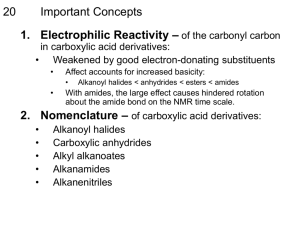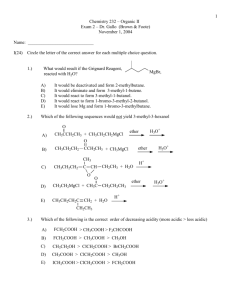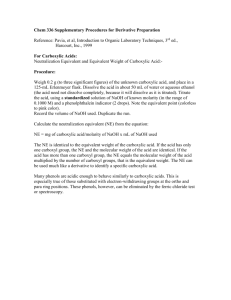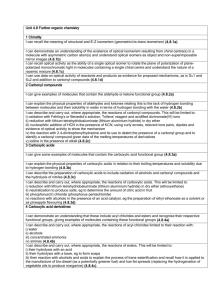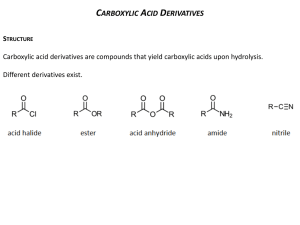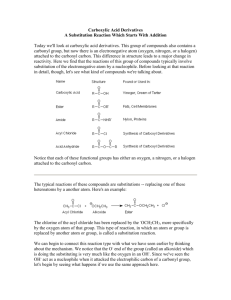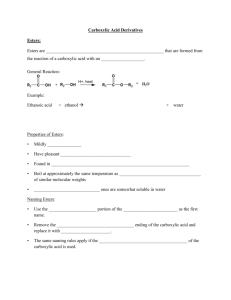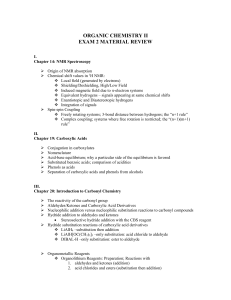carbox_acid_derv_rxn
advertisement
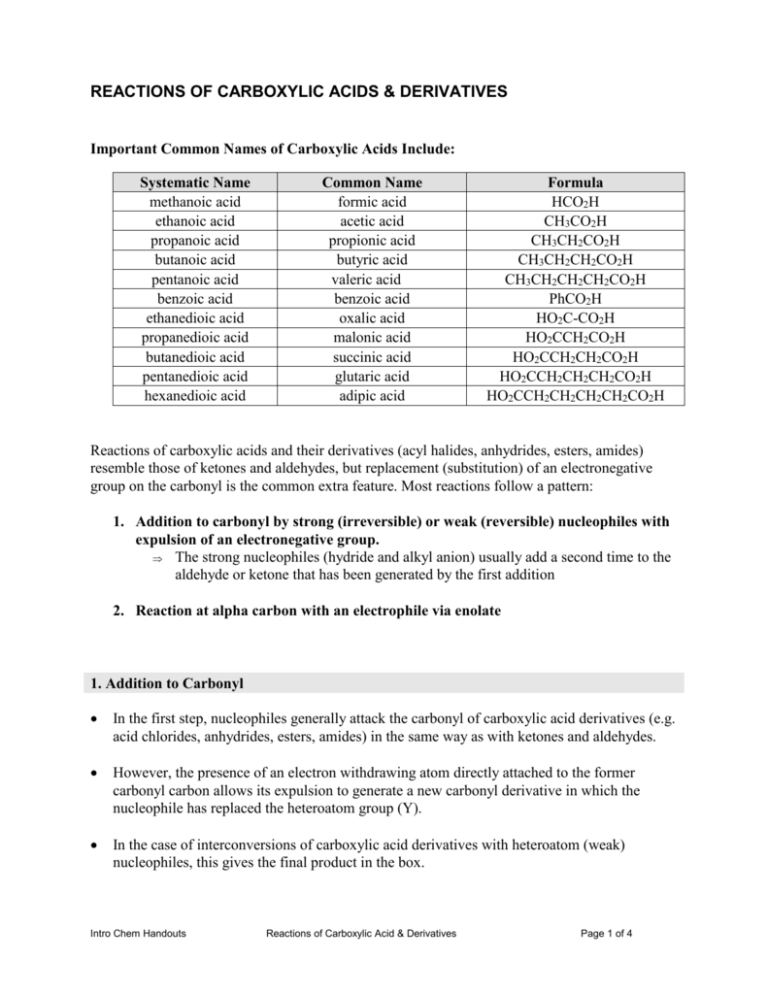
REACTIONS OF CARBOXYLIC ACIDS & DERIVATIVES Important Common Names of Carboxylic Acids Include: Systematic Name methanoic acid ethanoic acid propanoic acid butanoic acid pentanoic acid benzoic acid ethanedioic acid propanedioic acid butanedioic acid pentanedioic acid hexanedioic acid Common Name formic acid acetic acid propionic acid butyric acid valeric acid benzoic acid oxalic acid malonic acid succinic acid glutaric acid adipic acid Formula HCO2H CH3CO2H CH3CH2CO2H CH3CH2CH2CO2H CH3CH2CH2CH2CO2H PhCO2H HO2C-CO2H HO2CCH2CO2H HO2CCH2CH2CO2H HO2CCH2CH2CH2CO2H HO2CCH2CH2CH2CH2CO2H Reactions of carboxylic acids and their derivatives (acyl halides, anhydrides, esters, amides) resemble those of ketones and aldehydes, but replacement (substitution) of an electronegative group on the carbonyl is the common extra feature. Most reactions follow a pattern: 1. Addition to carbonyl by strong (irreversible) or weak (reversible) nucleophiles with expulsion of an electronegative group. The strong nucleophiles (hydride and alkyl anion) usually add a second time to the aldehyde or ketone that has been generated by the first addition 2. Reaction at alpha carbon with an electrophile via enolate 1. Addition to Carbonyl In the first step, nucleophiles generally attack the carbonyl of carboxylic acid derivatives (e.g. acid chlorides, anhydrides, esters, amides) in the same way as with ketones and aldehydes. However, the presence of an electron withdrawing atom directly attached to the former carbonyl carbon allows its expulsion to generate a new carbonyl derivative in which the nucleophile has replaced the heteroatom group (Y). In the case of interconversions of carboxylic acid derivatives with heteroatom (weak) nucleophiles, this gives the final product in the box. Intro Chem Handouts Reactions of Carboxylic Acid & Derivatives Page 1 of 4 If the nucleophile is very strong, such as R: - (alkyl anion from RLi or RMgX) or H: (hydride anion from LiAlH4 or NaBH4), there is no H+ present (the positive ion is a metal) and the product in the box is a ketone or aldehyde which will react with a second mole of nucleophile (see ketone reactions) to ultimately generate an alcohol (in the circle). Amides are an exception and give amines with LiAlH4 or NaBH4. In order to decide whether a reaction with a heteroatom nucleophile will work, the scheme shown below is useful: Intro Chem Handouts Reactions of Carboxylic Acid & Derivatives Page 2 of 4 In general, carboxylic acid derivatives that are more reactive can be spontaneously converted into less reactive ones by treatment with the appropriate nucleophilic species. The exceptions are carboxylic acids which will generally react with alcohols to form esters only under acidic conditions because under basic conditions the formation of unreactive salts is extremely rapid. The general reaction for formation of carboxylic acid derivatives is: Intro Chem Handouts Reactions of Carboxylic Acid & Derivatives Page 3 of 4 2. Reaction at alpha Carbon The general features of this type of reaction are analogous to the corresponding reactions of aldehydes and ketones. Of course the products will now be carboxylic acid derivatives. This type of reaction is particularly useful with esters. The base must be chosen carefully such that it does not act as a nucleophile and attack the carbonyl in a "Type 1" reaction. For esters, LDA (lithium diisopropylamide) at low temperature is especially useful as a base. Intro Chem Handouts Reactions of Carboxylic Acid & Derivatives Page 4 of 4
